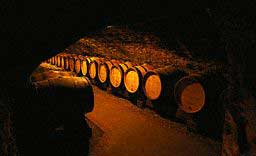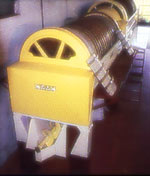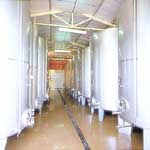|
The types of grape produced from the farm are mainly Pinot Grigio,
Chardonnay, Sauvignon and Tocai for the white
wines, Merlot, Cabernet Franc, Cabernet Sauvignon
and Refosco for the red ones.  The
cultivation of the grapes is overseen from a graduated technician
specialist of the diseases of the vine that, in compliance with
the CEE law n° 2078, prescribes the dunging, the sanitary treatments
against the Presospera and other typical adversities through advised
active principles, in way that residual or traces of injurious elements
does not remain in the wine. The health of the grapes is greatly
cured from us, so to prefer the manual grape-gathering with training
of our grape-gatherers just to remove eventual presences of rottenness
from the grapes. In our wines are present a third of the solforosa
admitted by the law in order not to give digestives disturbs and
tiresome headaches. The harvest takes place after repeated analyses
of the sugars, of the acidity and of the maturation of the grapes,
so to obtain a product with the right organoleptic characteristics.
. The
cultivation of the grapes is overseen from a graduated technician
specialist of the diseases of the vine that, in compliance with
the CEE law n° 2078, prescribes the dunging, the sanitary treatments
against the Presospera and other typical adversities through advised
active principles, in way that residual or traces of injurious elements
does not remain in the wine. The health of the grapes is greatly
cured from us, so to prefer the manual grape-gathering with training
of our grape-gatherers just to remove eventual presences of rottenness
from the grapes. In our wines are present a third of the solforosa
admitted by the law in order not to give digestives disturbs and
tiresome headaches. The harvest takes place after repeated analyses
of the sugars, of the acidity and of the maturation of the grapes,
so to obtain a product with the right organoleptic characteristics.
.
The white grape gathered and selected by hand has to be put
in soft press and, after two hours working for every filling, the
must is squeezed  without
pulping the peels so to avoid that colours and unpleasant tannins,
that could remove delicacy to the wine, came out from the peels.
The obtained must is left decanting and, after cooled, is poured
off so to remove the bottoms. At this point the must ferments for
some days at controlled temperatures ( 18 - 20 degrees) in stainless
barrels avoiding, in this way, changes temperature that could disperse
the flavours. Other common customs at the end of the fermentation
such as lowering the temperatures to decant the wines, eliminating
the potassium salts that in bottle could be formed without
pulping the peels so to avoid that colours and unpleasant tannins,
that could remove delicacy to the wine, came out from the peels.
The obtained must is left decanting and, after cooled, is poured
off so to remove the bottoms. At this point the must ferments for
some days at controlled temperatures ( 18 - 20 degrees) in stainless
barrels avoiding, in this way, changes temperature that could disperse
the flavours. Other common customs at the end of the fermentation
such as lowering the temperatures to decant the wines, eliminating
the potassium salts that in bottle could be formed ,
pouring off and filtrations after the harvest, render the white
wine ready for bottling. Other talk has to be made for the red wines
which are less delicates than the white, but they need longer times
of working inasmuch as their typologies can be different as different
are the tastes of the consumers. Today in the market we can find
red wines, like Novello, that are appreciated for their pleasantness
or vintage year and aged wines that are appreciated for the characteristics
that can only stand out after a wise working and in the long run
so to facilitate the various aromatic combinations and so to donate
flavours and different sensations. ,
pouring off and filtrations after the harvest, render the white
wine ready for bottling. Other talk has to be made for the red wines
which are less delicates than the white, but they need longer times
of working inasmuch as their typologies can be different as different
are the tastes of the consumers. Today in the market we can find
red wines, like Novello, that are appreciated for their pleasantness
or vintage year and aged wines that are appreciated for the characteristics
that can only stand out after a wise working and in the long run
so to facilitate the various aromatic combinations and so to donate
flavours and different sensations.
|
